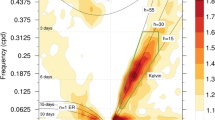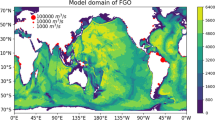Abstract
The convection and planetary boundary layer (PBL) processes play significant role in the genesis and intensification of tropical cyclones (TCs). Several convection and PBL parameterization schemes incorporate these processes in the numerical weather prediction models. Therefore, a systematic intercomparison of performance of parameterization schemes is essential to customize a model. In this context, six combinations of physical parameterization schemes (2 PBL Schemes, YSU and MYJ, and 3 convection schemes, KF, BM, and GD) of WRF-ARW model are employed to obtain the optimum combination for the prediction of TCs over North Indian Ocean. Five cyclones are studied for sensitivity experiments and the out-coming combination is tested on real-time prediction of TCs during 2008. The tracks are also compared with those provided by the operational centers like NCEP, ECMWF, UKMO, NCMRWF, and IMD. It is found that the combination of YSU PBL scheme with KF convection scheme (YKF) provides a better prediction of intensity, track, and rainfall consistently. The average RMSE of intensity (13 hPa in CSLP and 11 m s−1 in 10-m wind), mean track, and landfall errors is found to be least with YKF combination. The equitable threat score (ETS) of YKF combination is more than 0.2 for the prediction of 24-h accumulated rainfall up to 125 mm. The vertical structural characteristics of cyclone inner core also recommend the YKF combination for Indian seas cyclones. In the real-time prediction of 2008 TCs, the 72-, 48-, and 24-h mean track errors are 172, 129, and 155 km and the mean landfall errors are 125, 73, and 66 km, respectively. Compared with the track of leading operational agencies, the WRF model is competing in 24 h (116 km error) and 72 h (166 km) but superior in 48-h (119 km) track forecast.












Similar content being viewed by others
References
Anthes RA (1977) Hurricane model experiments with a new cumulus parameterization scheme. Mon Weather Rev 105:287–300
Anthes RA (1982) Tropical cyclones—their evolution, structure, and effects. Monograph No. 41, American Meteorological Society
Arakawa A, Schubert WH (1974) Interaction of a cumulus cloud ensemble with the large-scale environment. Part I. J Atmos Sci 31:674–701
Asnani GC (1993) Tropical meteorology, vols. 1 and 2, published by Prof. G.C. Asnani, c/o Indian Institute of Tropical Meteorology, Dr. Homi Bhabha Road, Pashan, Pune- 411008, India
Betts AK, Miller MJ (1986) A new convective adjustment scheme. Part II: single column tests using GATE wave, BOMEX, ATEX, and Arctic air-mass data sets. Quart J R Meteor Soc 112:693–709
Bhaskar Rao DV, Hari Prasad D (2007) Sensitivity of tropical cyclone intensification to boundary layer and convective processes. Nat Hazards 41:429–445
Braun SA, Tao W-K (2000) Sensitivity of high-resolution simulations of hurricane Bob (1991) to planetary boundary layer parameterizations. Mon Weather Rev 128:3941–3961
Carlson TN, Boland FE (1978) Analysis of urban-rural canopy using a surface heat flux/temperature model. J Appl Meteor 17:998–1013
Charnock H (1955) Wind stress on a water surface. Quart J R Meteor Soc 81:639–640
Dudhia J (2004) The weather research and forecasting model (Version 2.0). 2nd Int’l Workshop on Next Generation NWP Model. Seoul, Korea, Yonsei Univ., 19–23
Gray WM (1968) Global view of the origin of tropical disturbances and storms. Mon Weather Rev 96:669–700
Grell GA (1993) Prognostic evaluation of assumptions used by cumulus parameterizations. Mon Weather Rev 121:764–787
Grell GA, Devenyi D (2002) A generalized approach to parameterizing convection combining ensemble and data assimilation techniques. Geophys Res Lett., 29(14):Article 1693
Holland GJ (1984) Tropical cyclone motion: a comparison of theory and observations. J Atmos Sci 41:68–75
Hong S-Y, Pan H-L (1996) Nocturnal boundary layer vertical diffusion in a medium-range forecast model. Mon Weather Rev 124:2322–2339
Hong S-Y, Dudhia J, Chen S-H (2004) A revised approach to ice microphysical processes for the bulk parameterization of clouds and precipitation. Mon Weather Rev 132:103–120
Hong SY, Noh Y, Dudhia J (2006) A new vertical diffusion package with an explicit treatment of entrainment processes. Mon Weather Rev 134:2318–2341
IMD Atlas (2008) Tracks of storms and depressions in the Bay of Bengal and the Arabian Sea, India Meteorological Department, New Delhi, India
Janjic ZI (1994) The step–mountain eta coordinate model: further developments of the convection, viscous sublayer and turbulence closure schemes. Mon Weather Rev 122:927–945
Janjic ZI (2003) A nonhydrostatic model based on a new approach. Meteorol Atmos Phys 82:271–285
Kain JS (2004) The Kain-Fritsch convective parameterization: an update. J Appl Meteor 43:170–181
Kain JS, Fritsch JM (1993) Convective parameterization for mesoscale models: The Kain–Fritsch scheme. The representation of cumulus convection in numerical models, Meteorological Monograph, No. 46, American Meteorological Society, pp 165–170
Kuo H-L (1974) Further studies of the parameterization of the influence of cumulus convection on large-scale flow. J Atmos Sci 31:1232–1240
Kuo Y-H, Reed RJ, Liu Y-B (1996) The ERICA IOP 5 storm. Part III: Mesoscale cyclogenesis and precipitation parameterization. Mon Weather Rev 124:1409–1434
Mandal M, Mohanty UC, Raman S (2004) A study on the impact of parameterization of physical processes on prediction of tropical cyclones over the Bay of Bengal With NCAR/PSU mesoscale model. Nat Hazards 31:391–414
Mellor GL, Yamada T (1982) Development of a turbulence closure model for geophysical fluid problems. Rev Geophys Space Phys 20:851–875
Mohanty UC, Osuri KK, Routray A, Mohapatra M, Pattanayak Sujata (2010) Simulation of Bay of Bengal tropical cyclones with WRF model: impact of initial and boundary conditions. Mar Geodesy 33(4):294–314
Osuri KK, Mohanty UC, Routray A, Mohapatra M (2010) Impact of satellite derived wind data assimilation on track, intensity and structure of tropical cyclones over North Indian Ocean. Int J Remote Sens (accepted)
Pattnaik S, Krishnamurti TN (2007) Impact of cloud microphysical processes on hurricane intensity, part 1: control run. Meteorol Atmos Phys 97:117–126
Rao GV, Bhaskar Rao DV (2003) A review of some observed mesoscale characteristics of tropical cyclones and some preliminary numerical simulations of their kinematic features. Proc Ind Nat Sci Acad A 69:523–541
RSMC-Tropical cyclones (2008) A report on cyclonic disturbances over North Indian Ocena during 2008. India Meteorological Department, New Delhi
Ryerson WR, Rugg S, Elsberry RL, Wegiel J (2007) Evaluations of the AFWA weather research forecast model Western North Pacific tropical cyclone predictions, 27th conference on hurricanes and tropical meteorology, CA, 24–28 April 2006, (Paper 7A.5). Available at http://ams.confex.com/ams/pdfpapers/108856.pdf
Schaefer JT (1990) The critical success index as an indicator of warning skill. Weather Forecast 5:570–575
Sikora CR (1976) An investigation of equivalent potential temperature as a measure of tropical cyclone intensity. Technical note, JTWC, 76-3, 12 pp
Skamarock WC, Klemp JB, Dudhia J, Gill DO, Barker DM, Wang W, Powers JG (2005) A description of the advanced research WRF version 2, NCAR TECHNICAL NOTE
Vrieling A, Sterk G, de Jong SM (2009) Mapping rainfall erosivity for Africa with TRMM time series. Geophys Res Abstr 11:2034
World Meteorological Organization technical document (2008) Tropical cyclone operational plan for the Bay of Bengal and the Arabian Sea. Document No. WMO/TDNo. 84, 1
Yang MJ, Cheng L (2005) A modeling study of typhoon Toraji (2001): physical parameterization sensitivity and topographic effect. Terr Atmos Ocean Sci 16:177–213
Acknowledgments
The Indian National Center for Ocean Information Services (INCOIS) is gratefully acknowledged for providing financial support to carry out this research. The authors also owe thanks to IMD for providing best track parameters of TCs used for the validation of model-simulated results. The authors gratefully acknowledge the NCEP/NCAR for their analyses data sets used in the study. We also thank anonymous reviewers for their valuable comments to improve the quality of manuscript.
Author information
Authors and Affiliations
Corresponding author
Rights and permissions
About this article
Cite this article
Osuri, K.K., Mohanty, U.C., Routray, A. et al. Customization of WRF-ARW model with physical parameterization schemes for the simulation of tropical cyclones over North Indian Ocean. Nat Hazards 63, 1337–1359 (2012). https://doi.org/10.1007/s11069-011-9862-0
Received:
Accepted:
Published:
Issue Date:
DOI: https://doi.org/10.1007/s11069-011-9862-0




